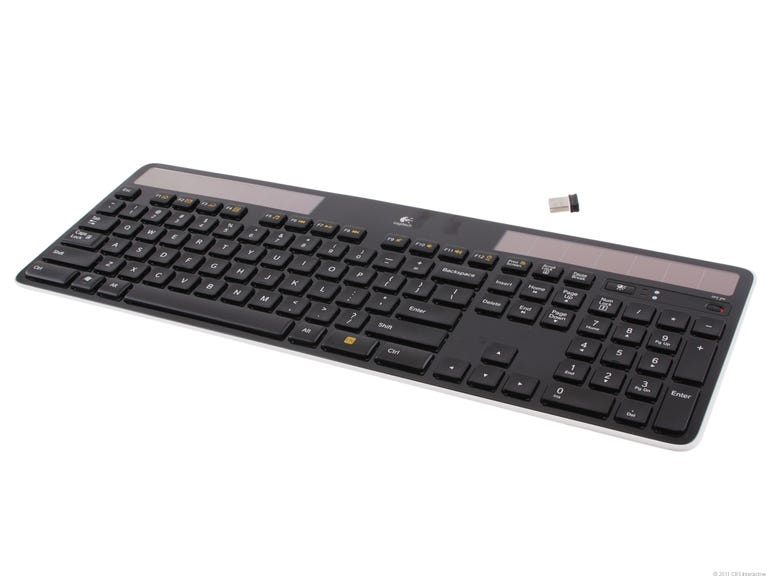 Why You Can Trust CNET
Why You Can Trust CNET Logitech Wireless Solar Keyboard K750 review: Logitech Wireless Solar Keyboard K750
Logitech Wireless Solar Keyboard K750
Logitech calls its $79 Wireless Solar Keyboard K750 an innovation in typing technology, and after using our evaluation model for a week, we certainly agree. The dual solar panels mounted on top of the superthin keyboard require zero user effort to keep the device charged and ready to type, while the accompanying Solar App desktop software shows precisely how much battery life is left. We're very much in favor of the Logitech K750, especially when partnered with Logitech's convenient Unifying Receiver, which lets you connect multiple Logitech input devices to a single USB plug. In fact, we're giving it an Editors' Choice Award, and recommend it to anyone shopping for a new keyboard.
The Good
The Bad
The Bottom Line
With its low-profile keycaps and a glossy black mirrored finish behind them, the K750 solar keyboard looks more like a disconnected laptop keyboard than its desktop counterparts. Unlike the mechanical keyboards currently popular in the peripheral market, this input device uses scissor switches underneath that register key presses with a lighter touch, and give the additional benefit of low noise. This type of keyswitch also allows Logitech to reduce the thickness of the keyboard chassis to just one-third of an inch.
The standout features on the K750 are obviously the dual solar panels that sit on either side of the logo branding on top of the keys. The panels power the integrated ML2032 lithium manganese button-cell rechargeable battery that then pushes power to the keyboard.
That's standard battery technology, but the solar panels can also draw perpetual power from artificial light sources--in other words, you don't have to raise the keyboard to the sun for it to work; the fluorescent bulbs above you will charge it just fine. Logitech claims that a single 2-hour charge will retain power for three months in total darkness, or more if you remember to flip the on/off switch when you step away.
Finally, on the small chance that the battery fails, you can replace it with a standard ML2032 battery, available from Logitech's parts store.
Just above the 10-key pad, you'll find a small "check light" key that indicates the remaining battery life using basic icons that everyone should understand: a green smiley-face lights up if you're powered up, and a red frown lets you know your light source is currently drawing less than 50 lux.
Logitech's effort to push the K750's eco-consciousness shows up at every turn, from the PVC-free chassis to the 100 percent recyclable packaging, and even the decision to include, rather than a CD, a link to the downloadable Solar App that displays exactly how much light is currently filtering through the panels. We were also surprised to see that no physical manual is included in the box; instead another link points you to an online manual available in PDF form.
The keyboard is plug-and-play so all you have to do is plug in the USB receiver to start typing, but you need to download Logitech's SetPoint software (version 6.2) to customize the one-touch F1 to F12 shortcut keys just below the solar panels. SetPoint also lets you swap specific F-key functions, disable inactive keys, and add more devices to your Unifying Receiver profile.
Though the K750 may appear aesthetically similar to other input devices, two Logitech-specific features distinguish it from the competition: the Unifying Receiver and PerfectStroke typing system.
With USB ports quickly filling up with hardwired peripherals like speakers, mice, and Webcams, we're happy to see that the K750 integrates Logitech's 2.4GHz Unifying USB microreceiver. The Mini-USB plug sticks out less than an inch from any standard USB and can work in conjunction with up to six other Logitech input devices for up to 10 meters away from the source.
Of course, buying into the Unifying line basically limits you to the Logitech brand, but the company consistently earns our favor across its entire line of peripherals, including desktop mice and portable mice.
The K750 uses Logitech's PerfectStroke key design that adds exactly 3.2mm of space between each key and uniform tactile feedback across the entire concave key surface. In practice, the key response is similar to that of an IBM ThinkPad laptop, so if you're used to typing on a regular keyboard, the K750 will be an acquired taste. Your accuracy might suffer in the interim, but we actually found ourselves typing faster after less than a week of using it.
Conclusions
With the exception of a glossy black chassis that reveals fingerprints and scratches, we can find little to complain about in Logitech's K750 solar keyboard. Logitech has made it painless to reduce your energy consumption, and the key architecture and typing experience are unmatched in the competition. For $80, we're hard-pressed to find a better deal than the Editors' Choice Award-winning Logitech K750.


